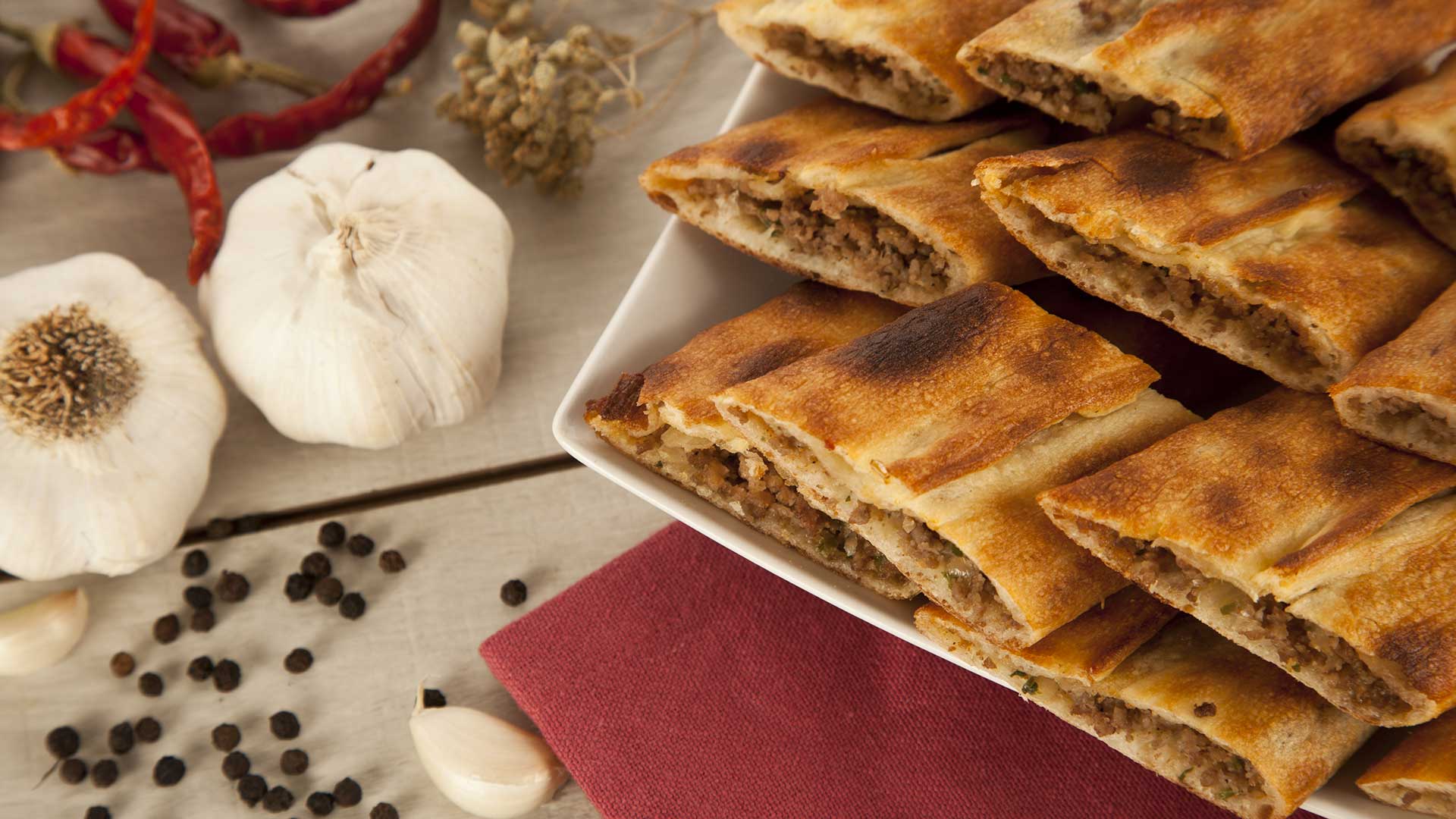LAMB FLATBREADS WITH MINT & NUT SALSA
2nd November 2019KISIR – TURKISH BULGUR SALAD
3rd November 2019Turkish Pide with Minced Beef (folded)
TURKISH PIDE WITH MINCED BEEF (FOLDED)
Pide – (pronounced “pea-day” in Turkish) – a long, oval-shaped yeast flatbread made from wheat flour, is one of the breads essential at Turkish meals. In one form or another, pide is traditional in all regions of Turkey and, whether baked at home or at a communal wood-fired bakery or purchased at ubiquitous pide stalls, unites families and friends at daily meals and at various life-cycle rituals. Pide is a must on Turkish tables, especially to break the fast during Ramadan.
Pide is versatile. It can be plain, lightly sprinkled with nigella or sesame seeds and served alongside other food. In Turkish vernacular, however, pide generally refers to a flatbread topped with meat, such as minced lamb or beef, onion and black pepper. But pide also can be filled with a myriad of other combinations such as diced meat with sautéed tomatoes and bell peppers, all vegetables, mushrooms and spinach, cheddar cheese, village cheese and parsley, spinach and cheese, and cheese and pastrami.
Although there are countless recipes for pide dough, many Turkish bakers, use one dough recipe with different toppings. Depending on the topping used, pide is baked both open as most are, where the dough is folded around the edges and the filling is visible or closed so none of the topping is visible. Some cooks crack an egg or two over an open pide toward the end of baking, so that slices can be dunked in the runny yolk.
Here is the recipe for pide with minced beef -closed- (Kapali Kiymali Pide as it is called in Turkish).
INGREDIENTS
For the dough
- 5 cup all purpose plain flour
- 1 medium potato – boiled and chopped
- Half pack fresh yeast (21g)
- 100ml sunflower oil
- 2 tbsp plain / greek yoghurt
- 1 tbsp sugar
- 2 tsp salt
- Enough water (around 60% to have soft dough.)
For the filling
- 400g minced beef
- 3 medium onion, finely chopped
- 3 cloves garlic, minced
- 2 long green pepper or ½ green bell pepper, finely diced
- 3 tbsp sunflower oil
- half bunch parsley, chopped
- Sprinkle fresh thyme to taste
- 50ml tomato sauce or 1tbsp tomato paste dissolved in 50ml water
- 1tsp salt
- Black pepper to taste
- Ground red pepper or chili pepper to taste
- Dried basil to taste
METHOD
The dough
- In a large mixer bowl, mix flour, fresh yeast, oil, yogurt, salt, sugar and potato.
- Add water as little as you can and knead – first within bowl then onto your work surface – until you get a soft, smooth dough with the consistency of ear lobes.
- Cover the dough with a damp cloth and set aside in a warm spot until dough bubbles and doubles in size (I set aside for at least 6 hours).
The filling
- In a large pan, heat the oil and fry the garlic and onion until softened
- Add the minced meat and continue to cook, stirring continuously.
- Add chopped parsley, green pepper, thyme, tomato sauce, salt, black pepper, ground red pepper and basil and sauté for another 2-3 min
Assembling
- Once the dough has risen, place the dough on a lightly floured surface. Knead the dough for a minute then divide the dough into egg-sized pieces and roll into balls. Let it rise for 5 min.
- On a lightly floured surface, roll the dough balls into oval shapes with ½ cm (0.2”) thickness.
- Line a large baking tray with baking paper and place the oval flat breads dough on the tray.
- Spread the filling evenly over the flat breads, leaving 2 cm at the edges as a border with no filling (it is easier to spread the filling while the oval flat bread is in the tray).
- Smooth and flatten filling and fold in border from both sides to cover the filling, pinching along the center and at ends to create an oval boat shape. The meat filling should be completely covered.
- Paint pide with egg wash and prick surface with a skewer to release steam.
- Transfer to oven and bake in a preheated oven at 180ºC for about 20- 25 minutes, or until lightly golden with a crisp crust.
- Once cool, cut into slices and serve.




